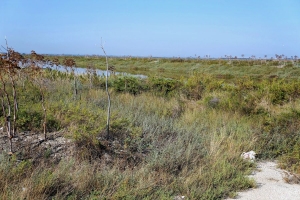

 +14Kontinente:EU
+14Kontinente:EU1. Lebendfotos
1.1. Falter
2. Diagnose
2.1. Männchen
2.2. Weibchen
2.3. Geschlecht nicht bestimmt
2.4. Genitalien
2.4.1. Männchen
2.4.2. Weibchen
2.5. Erstbeschreibung
3. Biologie
3.1. Habitat
3.2. Nahrung der Raupe
- [Fabaceae:] Lotus cytisoides [= Lotus allioni] (Geißkleeartiger Hornklee)
- [Fabaceae:] Lotus glaucus
- [Asteraceae:] Phagnalon sordidum ??? [= Conyza sordida, Gnaphalium conyzoideum, Gnaphalium sordidum ???] (Mehrköpige Steinimmortelle ???)
Constant (1883: 9-10) beschreibt die variable Raupe aus Südfrankreich und erklärt: "Vit au printemps d'abord, puis en juillet-aout, sur le Lotus Allionii, et sans doute aussi sur d'autres espèces. La génération du printemps passe sa vie dans la terre, où elle se construit un tube de soie dans l'ouverture aboutit en dehors, a portée des feuilles qui touchent au sol. La chenille dété habite également une galerie tubulaire; mai celle-ci est simplement fixée par un bout à la surface du sol, et de là s'étend le long des tiges de la plante, en s'allongeont à mesure que la chenille dévore les feuilles. Les excréments sont rejetés au dehors." Leraut (2014: 333) wiederholt die Nennung dieser Nahrungspflanze (als Lotus cytisoides) ohne Quellennennung, Ylla et al. (2015) nennen wenigstens die Quelle.
Aguiar & Karsholt (2006: 60) können berichten: "N. coenulentella was recently recorded from Madeira by MEYER (1997: 46), based on two specimens from Ponta de São Lourenço. In ZMUC there is a long series from this locality dating back to 1977, and also specimens from Porto Santo. In the first mentioned locality the larva have been found feeding in spun tubes on Lotus glaucus (Leguminosae)." Lotus glaucus ist ein Endemit von Madeira und der Selvagens Inseln.
Leraut (2014: 333) listet neben Lotus cytisoides auch noch Phagnalon sordidum - wieder ohne Quellenangabe. Die Meldung wurde sehr oft abgeschrieben, eine Quelle zur der Meldung ist mir aber immer noch nicht bekannt. Ich halte die Angabe für wahrscheinlich falsch.
4. Weitere Informationen
4.1. Etymologie (Namenserklärung)
„coenulentus kotig.“
4.2. Andere Kombinationen
- Nephopteryx coenulentella Zeller, 1846 [Originalkombination]
- Nephopterix coenulentella Zeller, 1846
- Sciota coenulentella (Zeller, 1846)
- Neurotomia coenulentella (Zeller, 1846) [so bis Slamka (2019) übliche Kombination]
4.3. Synonyme
- Nephopterix maculata Staudinger, 1876
- Neurotomia algeriella Chrétien, 1911
4.4. Taxonomie
Slamka (2019: 103) nimmt die Neukombination mit Melathrix vor.
4.5. Faunistik
Slamka (2019: 104) listet auf: "Portugal, Madeira, Spain, Ibiza, Canary Is., S France, Corsica, Sardinia, Sicily, Malta, Cyprus. Data from Cyprus (Arenberger, 1994) and Lebanon (Leraut, 2014) need to be verified, they could belong to M. praetextella or M. proteella. Similarly, the data from Amsel (1933) - Palestine and Syria probably belong to these species."
(Autor: Erwin Rennwald)
4.6. Literatur
- Aguiar, A.M.F. & O. Karsholt (2006): Systematic catalogue of the entomofauna of the Madeira archipelago and Selvagens Islands. — Boletim do Museu Municipal do Funchal (História Natural), Suppl. 9: 5-139. [PDF auf curis.ku.dk] bzw. [PDF auf zmuc.dk]
- Constant, A. (1883): Observations sur quelques chenilles nouvelles ou imparfaitement connues. — Annales de la Société entomologique de France, 6 (3): 5-20. [Digitalisat auf gallica.bnf.fr]
- Leraut, P. (2014): Moths of Europe. Volume 4. Pyralids 2. - 441 S.; Verrières-le-Buisson (N.A.P Editions).
- Slamka, F. (2019): Pyraloidea (Lepidoptera) of Europe. Volume 4. Phycitinae - Part 1. Identification - Distribution - Habitat - Biology. - 432 S., 175 Taf. mit Genitalabb., 31 Farbtaf. mit mehr als 900 Bildern zu 207 Arten; Bratislava (Eigenverlag František Slamka).
- Ylla, J., Macià, R., & M. Huertas Dionisio (2015): Pirálidos y Crámbidos detectados en Almería, España, 2ª parte (Lepidoptera Pyraloidea). — SHILAP Revista de Lepidopterología 43 (172): 525-536. [PDF auf redalyc.org]
- Erstbeschreibung: Zeller, P. C. (1846): Die knotenhornigen Phyciden. — Isis von Oken 1846: 729-788. Leipzig (Brockhaus).













































